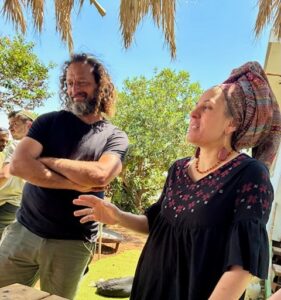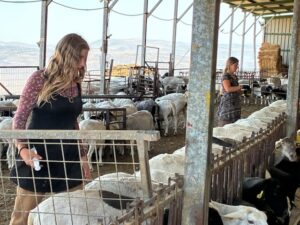Story and Photos by Steve Kramer

KFAR SABA, Israel — Michal and I lived in Samaria for 25 years before moving several miles westward to the city of Kfar Saba, which is just inside the 1949 Armistice Line (aka Green Line – not a border).
Samaria and Judea are ancient areas whose names, dating from Biblical times, were supplanted in 1950 by the so-called ‘West Bank’, which nearly erased their names after thousands of years. (e.g. Jews are from Judea.) This name change was a brilliant propaganda move by the Jordanian royal family, the Hashemites. They were ‘parachuted’ by Britain into eastern Palestine (first Transjordan, now Jordan) after the Hashemites had been usurped in the Mecca/Medina region by the Saudi clan – today’s Saudi Arabia.
The original British Mandate designated land on both sides of the Jordan River as a national home for the Jews: “…the establishment in Palestine of a national home for the Jewish people.”
Our most recent tour with the IDSF (Israel Defense and Security Forum) into Samaria began in Tsofim, founded in 1989 just across a narrow valley from Alfe Menashe, our former home. Our guide, Boaz, explained how communities of Israelis on the eastern side of the Armistice Line necessarily require IDF protection. The resultant military buildup protects all Israelis, especially at its most narrow width (8-9 miles), where Tsofim is located, overlooking the large Palestinian Authority city of Kalkilya. An IDF base is adjacent to Tsofim. Without these settlements, there would be no reason to have an army presence, thereby leaving the area open to terrorist buildup with easy access to cities on the western side of the Armistice Line.
It’s interesting that Samaria and Judea, both hilly, are the homeland of the Jews, not the verdant valleys. After the Exodus from Egypt (14th or 15th century BCE) and Joshua’s entrance into the Land of Israel with the Israelites, they chose the mountain tops. This gave them a military advantage over the Canaanites, who preferred the valleys below.
We learned that following the 1993 Oslo Peace Accords, Prime Minister Yitzhak Rabin built many bypass roads and instituted armored buses for public travel in Judea and Samaria. (We were traveling on an armored bus.) Increased population and industrial and residential development resulted from the strong Israeli presence. After walking to a nearby lookout point at about 1,000 ft, we had a panoramic view of the metropolitan Tel Aviv area, plus far north and south of Tel Aviv. We then boarded our bus and headed further into Samaria.
We drove through beautiful hilly landscapes on our way to Itamar, located on the hills southeast of Biblical Shechem. [see Note] It is situated on a hilltop overlooking the Jordan Valley, about 15 kilometers [10 miles] east of the Palestinian city of Nablus, which includes the archaeological remains of Shechem. Established in 1984, Itamar’s 1,200 residents are predominately Orthodox Jews. To the east of the village are a number of agriculture farms and outposts, some of which we visited.
We learned about Avri Ran, a successful Israeli businessman who had been an officer in the fabled Sayeret Matkal commando unit. He became interested in farming in Samaria and started one farm after another, always trying to open the land to Jewish initiatives. Whenever he started developing, some of the local Arabs would move on. There are about 70 new farms in this area, adding to the 30 more established ones. We learned that farms control much more land with fewer people than small communities. Therefore less friction arises with the Arabs in the vicinity. Avri Ran lives in one of the communities he developed, Giv’ot Olam Farm..
Avri Ran is a forerunner in building farms to preserve land from encroachment by EU-Palestinian Authority in Area C* of the Oslo Accords, an area that Israel solely controls. Not unexpectedly, the EU and the Palestinian Authority are constantly trying to undermine the Israeli population, building unauthorized homes and schools on land reserved for Jewish communities – flying the EU flag!
*The territory beyond the Armistice Line is divided into three parts. According to the Oslo Accords, Area C is under total control of Israel; Area B’s control is shared with the PA; Area A is controlled by the PA.

Near Itamar we experienced a major highlight of the trip at the farm of Tomer and Meital. They have a large farm situated high above the Jordan Valley, which separates Israel from Jordan across the eponymous river. They live with their 10 children in a somewhat makeshift house, but they are currently constructing a permanent home. They settled in this location 16 years ago, after living in the Golan Heights. They sought a new challenge and they certainly found one in the mountains of Samaria.

Tomer told us that when they first arrived there were Arabs living in the area. There were some troubles but eventually they left the Jews alone; some even left the area. Thievery is definitely a problem, so extra care has to be taken with the goats and sheep on their farm. Tomer told us about life in their little spot of heaven, where the kids (and young volunteers) all have their appointed jobs, allowing the parents to open a small boutique winery, the “Tom” brand. Their red and white wines have won prizes in boutique winery competitions. They even won a prize for best small boutique winery, including 3 first prizes and 2 second prizes.
Co-head of a religious family, Tomer says they feel they are literally living the Bible. In war, like the one we are now engaged in, they believe the Jews fight to promote eternity and the holy temple. Tomer says: “What we have living out here is something very special that you can’t know living in the center of the country.” Tomer and Meital, with their beautiful family, are pioneers who aren’t daunted by living in an area with Arabs.
You may wonder why Israelis are willing to live in areas beyond the Armistice Line populated by Arabs. Simply put, because it is our birthright promised and given to us by our Creator; because it is ours by ‘international law’ via the League of Nations and the United Nations; because of the fact that we are the people who had two kingdoms here, King David’s (circa 1,000 BCE) and the Hasmoneans (140 BCE); and because the Jews have a functioning government and control the borders.
Above all, Jews are the indigenous people of Israel, who settled here more than 4,000 years ago, and who regained sovereignty after losing it to the Greeks, the Romans, and the Muslims. No other people have any claim that stands up to ours. That’s the reason that brave Israelis are willing to live among Arabs in our homeland.
This was an eye-opening tour of a part of Samaria far beyond where we resided in Alfe Menashe. On the way home we enjoyed fabulous mountain and Jordan Valley views. We stopped briefly in the town of Elon Moreh, This is recorded in the Bible: The plains of Moreh is the first place that Abram (later: Abraham) comes to from his native country with his wife and family. God appears to him in the plains of Moreh, and he is told to build an altar on a mountain near Shechem to commemorate the event of arriving to the promised land.
This trip was sponsored by the IDSF. “At the core of IDSF lies the belief that Israel’s security must be anchored in its ability to protect itself, by itself, while actively thwarting threats to its safety. The authoritative voices of well-known military veterans, media personalities and national security experts, are key in disseminating our security strategy for the State of Israel.”
Israel is building 22 new settlements for the reasons mentioned above.
Note: Shechem is an important part of the history of the Jews. Abram (later, Abraham) was first promised the Land of Israel for his progeny there. Shechem was the place where Joseph’s remains were buried. The embalmed body of Joseph, who was second only to the Pharaoh in Egypt, was carried to Shechem for burial in the Land of Israel by Moses when the Hebrews left Egypt. Today Joseph’s Tomb is located in the modern Arab city of Nablus/Shechem, where Jews can make a pilgrimage to the Tomb, but only when escorted by the IDF.
The tomb is often desecrated by the Arabs despite the fact that Joseph is considered a Muslim holy prophet. During the time of the divided kingdom of Israel, Shechem was for a time the capital of the Northern Kingdom. (Jerusalem was the capital of the Southern Kingdom of Judea.)
*
Steve Kramer is an American-Israeli freelance writer based in Kfar Saba, Israel.